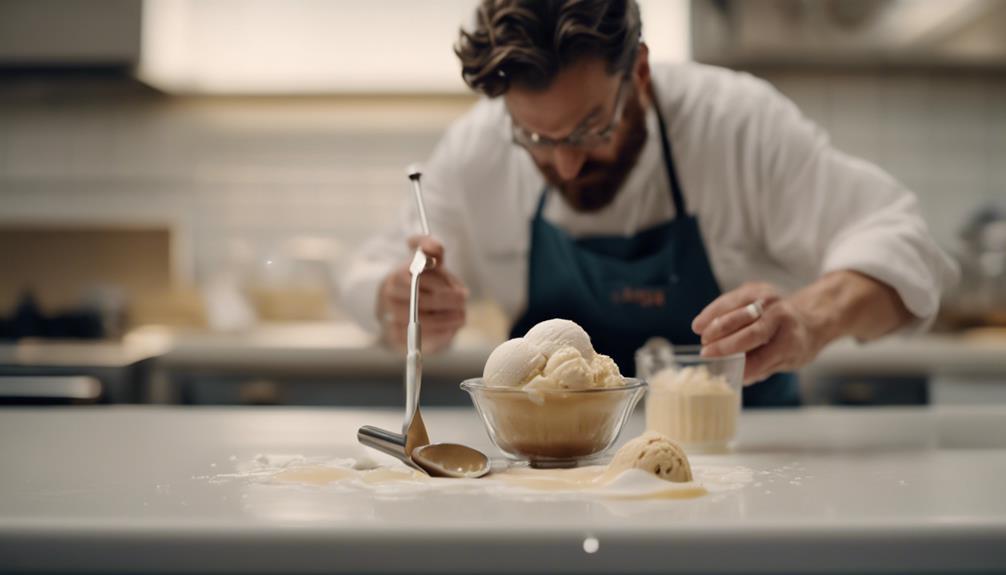For the best gelato experience, it is recommended to serve it between 8°F (-13°C) and 12°F (-11°C) to enjoy the perfect scoop. This temperature range will maintain its creamy texture and rich flavor. If the gelato is too cold, it can become hard and difficult to savor. Letting it sit at room temperature for 15-20 minutes can enhance its creamy texture. Remember to store gelato at around -10°F (-23°C) to preserve its quality. Proper handling during transport is also essential. Stay tuned for more insightful tips to make the most of your gelato experience.
Key Takeaways
- The ideal serving temperature for gelato is between 8°F (-13°C) and 12°F (-11°C) for optimal flavor and texture.
- Allow gelato to sit at room temperature for 15-20 minutes before serving to enhance creaminess.
- Use a strong metal scooper to effectively handle gelato's firmer texture.
- Limit exposure to room temperature to prevent ice crystal formation and maintain quality.
Importance of Proper Storage
Proper storage of gelato is essential to maintain its creamy texture and rich flavor, preventing the formation of unwanted ice crystals. Gelato contains about 60% water, so keeping it at the ideal freezer storage temperature of -10°F (-23°C) is vital. This stable environment helps preserve the quality of your gelato over time, allowing you to enjoy every scoop without compromising its delightful characteristics.
If you expose gelato to frequent temperature fluctuations, it can lead to the development of large ice crystals, which ruin the smooth texture you love. To combat this, store your gelato in airtight containers. This minimizes air exposure, which can lead to flavor loss and further ice crystal formation.
Regularly monitoring your freezer conditions is also key. Make certain your gelato stays at the right temperature, as this will extend its shelf life and maintain its intended qualities.
Ideal Serving Temperature

The ideal serving temperature for gelato lies between 8°F (-13°C) and 12°F (-11°C) to guarantee you enjoy its creamy texture and vibrant flavors.
When gelato is served too cold, below 12°F, it can become hard and icy, making it difficult to savor. On the other hand, serving it too warm leads to excessive melting and a loss of structure, which detracts from your experience.
To achieve that perfect scoop, consider allowing the gelato to sit at room temperature for about 15-20 minutes before serving. This small wait can help the gelato reach that ideal serving temperature, enhancing its creaminess and flavor.
Maintaining a consistent serving temperature is vital; fluctuations can create ice crystals that compromise the gelato's quality.
If you're using an ice cream maker, pay close attention to the serving temperature once your gelato is ready. Properly stored gelato can retain its delightful texture, but it's important to avoid letting it completely melt before you dig in.
Transportation and Handling Tips

When you're transporting gelato, using coolers or thermal bags with ice packs is essential to keep it from melting and losing its creamy texture. Minimize the time your gelato spends outside of cold storage to guarantee it maintains its quality during transportation. Warm environments can greatly impact its consistency and flavor, so always aim to keep it in a cool place.
Upon arrival, make sure to return the gelato to the freezer immediately. This step is vital for maintaining its ideal serving temperature and preventing the formation of ice crystals, which can ruin that smooth texture you love.
If you need to serve it shortly after transportation, allow the gelato to sit at room temperature for a brief period to soften it slightly. However, be cautious not to leave it out for too long, as prolonged exposure to warmth can compromise its quality.
Effective Serving Techniques

Mastering effective serving techniques guarantees your gelato maintains its delightful texture and flavor, making every scoop a treat. To achieve this, keep your gelato stored at an ideal temperature of 8°F (-13°C). When you're ready to serve, consider letting it soften in the fridge for 15-20 minutes. This brief period enhances the flavor and creaminess without completely melting it.
Using a strong, metal scooper is essential, as gelato tends to freeze harder than ice creams due to its lower fat content. Minimize the time gelato spends at room temperature to avoid ice crystal formation, which can degrade texture.
Here's a quick reference table to help you remember these techniques:
| Technique | Description |
|---|---|
| Scoop from Freezer | Start scooping straight from the freezer. |
| Softening | Let it soften for 15-20 minutes in the fridge. |
| Metal Scooper | Use a strong scooper for easier serving. |
| Limit Room Temperature Time | Serve quickly to maintain texture. |
| Return to Freezer | Promptly store leftovers back in the freezer. |
Follow these tips, and you'll serve gelato like a pro!
Shelf Life and Quality

To keep your gelato tasting its best, you need to focus on proper storage techniques.
Regularly monitoring freezer conditions is essential, as even slight temperature fluctuations can affect its creamy texture and flavor.
Proper Storage Techniques
Maintaining the right storage conditions is crucial for preserving gelato's flavor and texture over time. To do this, you need to adhere to proper storage techniques.
First, guarantee your freezer temperature remains consistently at -10°F (-23°C). This freezing point prevents ice crystal formation, which can ruin the smooth texture and rich taste of your gelato.
Frequent temperature fluctuations can lead to degradation; consequently, limit how often you open the freezer door. Store gelato in small containers to control portions and avoid unnecessary refreezing of leftovers. This way, you minimize air exposure, which can compromise quality over time.
Keep in mind that artisanal gelato, often made without preservatives, has a shorter shelf life than regular ice cream. Regularly check your freezer conditions to maintain peak preservation.
Monitoring Freezer Conditions
Keeping an eye on freezer conditions is vital for preserving gelato's shelf life and ensuring its quality remains intact. You need to store gelato at an ideal temperature of -10°F (-23°C) to prevent ice crystal formation and maintain flavor integrity.
Regularly check freezer temperatures with an accurate thermometer; fluctuations above this perfect range can compromise the creamy texture and taste you aim for.
Artisanal gelato, which lacks preservatives, typically lasts only a few days to a week when stored in consistently cold conditions. It's important to maintain a steady, cold temperature.
Even brief exposure to warmer conditions can lead to melting, resulting in poor re-freezing. This process increases the amount of ice in your gelato, affecting its overall quality.
Challenges in Home Gelato Making

Making gelato at home comes with its own set of challenges.
Your freezer's temperature isn't cold enough, which can lead to a hard and icy texture that's far from ideal.
Plus, if you refreeze melted gelato, you'll end up with an even worse texture, making it tough to achieve that perfect scoop.
Freezer Temperature Limitations
Storing gelato in a typical home freezer often leads to challenges, as the standard temperature of 0°F (-18°C) creates a texture that's too hard and icy for an enjoyable experience. You want your gelato to be creamy and flavorful, but when it's too cold, it loses that delightful consistency. Instead of relishing your treat, you might find yourself dealing with frustrations like these:
- You're left chipping away at frozen blocks of ice instead of scooping smooth gelato.
- You have to wait and let it melt, ruining the spontaneous joy of indulging in a sweet dessert.
- The flavor's muted, leaving you craving that rich, creamy taste you expected.
To truly savor your homemade gelato, aim for a warmer storage temperature of 10-22°F (-12 to -6°C). This allows the gelato to maintain its soft texture and enhance flavor.
Just remember, patience is key! When you take it out, let it melt a bit before diving in. This little extra time can transform your gelato experience from disappointing to divine. Embrace the wait for that perfect scoop!
Texture Degradation Issues
While improper freezer temperatures can harden your gelato, the real challenge lies in how texture degrades once it's served and exposed to fluctuating conditions. You want great gelato to maintain its creamy texture, but improper handling can lead to issues. Here's a quick overview of common texture degradation problems:
| Issue | Impact on Gelato |
|---|---|
| Melting at the edges | Increases ice crystal size |
| Extended serving time | Loses creaminess and softness |
| Frequent temperature changes | Compromises overall texture |
When gelato sits out, especially in a home environment, it starts to lose its ideal consistency after just a few hours. The lower fat content in gelato makes it freeze harder than ice cream, making it more prone to texture degradation if not kept at suitable temperatures around -10°F (-23°C). To enjoy your gelato at its best, be mindful of how long it's exposed to serving conditions. The less time it spends melting, the better your experience will be!
Refreezing Challenges
Refreezing gelato after it's melted can lead to larger ice crystals, ruining the creamy texture that makes it so delightful. When you take the gelato out of the freezer, it's tempting to just pop it back in after serving, but this can create real refreezing challenges. Each time you do this, the texture deteriorates, leaving you with a less enjoyable treat.
Here are three things to keep in mind:
- Temperature Fluctuations: Every time you refreeze, the temperature changes cause the ice crystals to grow, impacting the gelato's smoothness.
- Freezer Temperature: Home freezers usually operate at 0°F (-18°C), which isn't cold enough for ideal gelato preservation, leading to a harder, icy texture over time.
- Patience Matters: Allowing your gelato to soften slightly before serving enhances the flavor, but be careful not to let it melt too much, or you'll face even more refreezing challenges.
To maintain that perfect scoop, remember that preserving texture means managing how often you refreeze your gelato. Treat it right, and you'll savor every creamy bite!
Frequently Asked Questions
What Is the Best Temperature to Serve Gelato?
To enjoy gelato at its best, serve it between 8°F and 10°F. This temperature enhances the flavors and creaminess without compromising texture, ensuring you experience the delightful taste and smooth consistency gelato offers.
What Is the Best Way to Serve Gelato?
"Good things come to those who wait." To serve gelato perfectly, let it sit at room temperature for 15-20 minutes. Use a strong scooper and return leftovers quickly to maintain its creamy goodness. Enjoy!
What Temperature Should Ice Cream Be at to Scoop?
For easy scooping, ice cream should be between 0 to +6°F. If it's too cold, you'll struggle to scoop; maintaining the right temperature guarantees a smooth, creamy texture for perfect servings every time.
How Do You Scoop Gelato?
Scoop gelato smoothly by letting it sit briefly, then use a strong, metal scooper. Dipping it in warm water creates clean, creamy scoops. Practice makes perfect, so keep your scooper spotless for sensational servings!
What Temperature Should Gelato be Served at with Different Ingredients?
When it comes to the perfect serving temperature for gelato, it’s important to consider the specific gelato ingredients explained here. For fruit-based gelato, serving it at a slightly warmer temperature can help bring out the flavors. However, for chocolate-based gelato, a slightly colder temperature can enhance the rich, creamy texture.
What is the Best Serving Temperature for Gelato with Different Ingredients?
When it comes to enjoying gelato, the best serving temperature can vary depending on what’s in gelato?. Creamier flavors like chocolate or hazelnut are best served at a slightly warmer temperature, around 15-20 degrees Fahrenheit, while fruit-based flavors like lemon or raspberry are best enjoyed at a cooler temperature of 10-15 degrees Fahrenheit.
Conclusion
In the world of gelato, temperature is the sun that nurtures your scoop, transforming it from mere frozen cream into an unforgettable experience.
By understanding proper storage, serving techniques, and handling, you're not just preserving a treat; you're crafting a moment of joy.
Just as a flower blooms when given the right conditions, your gelato shines when served at the perfect temperature.
Embrace these tips, and let your gelato bring warmth to every gathering, one delightful scoop at a time.
















